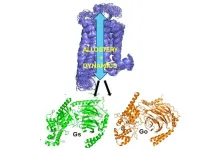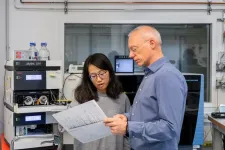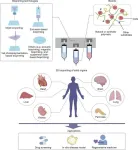(Press-News.org) About The Study: Between 14 and 27 weeks’ gestation, novice users with no prior training in ultrasonography estimated gestational age as accurately with the low-cost, point-of-care artificial intelligence (AI) tool as credentialed sonographers performing standard biometry on high-specification machines. These findings have immediate implications for obstetrical care in low-resource settings, advancing the World Health Organization goal of ultrasonography estimation of gestational age for all pregnant people.
Quote from corresponding author Jeffrey S. A. Stringer, MD:
“Our study demonstrates that an AI-enabled, portable ultrasound device can estimate gestational age as accurately as an expert sonographer using an expensive, high-specification machine. This high degree of accuracy was obtained even though the users of the device had no formal training in sonography.
“The most important takeaway is the potential democratization of a critical prenatal diagnostic tool. By enabling accurate gestational age estimation without the need for expensive equipment or specialized training, this technology could significantly expand access to quality prenatal care in resource-limited settings worldwide.
“This research could transform prenatal care delivery globally. In areas where ultrasound was previously unavailable, patients can now receive timely, accurate gestational age estimates, crucial for identifying high-risk pregnancies and guiding appropriate care. Health care providers in remote or underserved areas can offer expert-level diagnostics without extensive training, potentially leading to improved maternal and neonatal outcomes on a large scale.”
Contact information for Jeffrey S. A. Stringer, MD: email jeffrey_stringer@med.unc.edu.
To access the embargoed study: Visit our For The Media website at this link https://media.jamanetwork.com/
(doi:10.1001/jama.2024.10770)
Editor’s Note: Please see the article for additional information, including other authors, author contributions and affiliations, conflict of interest and financial disclosures, and funding and support.
# # #
Embed this link to provide your readers free access to the full-text article This link will be live at the embargo time https://jamanetwork.com/journals/jama/fullarticle/10.1001/jama.2024.10770?guestAccessKey=35480dc0-b13a-4c82-ae68-19aa19d01fab&utm_source=For_The_Media&utm_medium=referral&utm_campaign=ftm_links&utm_content=tfl&utm_term=080124
END
Diagnostic accuracy of an integrated AI tool to estimate gestational age from blind ultrasound sweeps
JAMA
2024-08-01
ELSE PRESS RELEASES FROM THIS DATE:
Aspirin use and incidence of colorectal cancer according to lifestyle risk
2024-08-01
About The Study: Aspirin use was associated with a greater absolute reduction in risk of colorectal cancer among individuals with less healthy lifestyles in this cohort study. The findings of the study suggest that lifestyle risk factors may be useful to identify individuals who may have a more favorable risk-benefit profile for cancer prevention with aspirin.
Corresponding Authors: To contact the corresponding authors, email Andrew T. Chan, MD, MPH (achan@mgh.harvard.edu) and Long H. Nguyen, MD, MS (lnguyen24@mgh.harvard.edu).
To access the embargoed study: Visit our For The Media website at this link https://media.jamanetwork.com/
(doi:10.1001/jamaoncol.2024.2503)
Editor’s ...
State abortion policy and moral distress among clinicians providing abortion after the Dobbs decision
2024-08-01
About The Study: In this purposive national survey study of clinicians providing abortion, moral distress was elevated among all clinicians and more than twice as high among those practicing in states that restrict abortion compared with those in states that protect abortion. The findings suggest that structural changes addressing bans on necessary health care, such as federal protections for abortion, are needed at institutional, state, and federal policy levels to combat widespread moral distress.
Corresponding Author: To contact the corresponding author, ...
Universal background checks, permit requirements, and firearm homicide rates
2024-08-01
About The Study: This cross-sectional study found that universal background checks alone were not associated with firearm homicide rates, but a permit requirement for the purchase and possession of firearms was associated with substantially reduced rates of firearm homicide. The findings suggest that combining universal background checks and permit-to-purchase requirements is an effective strategy for firearm-related fatality reduction.
Corresponding Author: To contact the corresponding author, Michael Siegel, MD, MPH, email mike.siegel@tufts.edu.
To access the embargoed study: Visit our For The Media website at this link https://media.jamanetwork.com/
(doi:10.1001/jamanetworkopen.2024.25025)
Editor’s ...
Joseph Rogers, MD, named to American Board of Internal Medicine’s Cardiovascular Board
2024-08-01
Houston, Texas, July 24, 2024 – The Texas Heart Institute, a globally renowned cardiovascular health center, announced today that Joseph G. Rogers, MD, President and Chief Executive Officer for The Texas Heart Institute and Adjunct Professor in the Division of Cardiology at Duke University, has been appointed by the American Board of Internal Medicine (ABIM) to its Cardiovascular Board for a three-year term beginning July 1, 2024.
“I am honored to have been appointed to this esteemed group ...
Study examines effect of fish oil in older adults’ brains
2024-08-01
A clinical trial at Oregon Health & Science University suggests that a subset of older adults with a genetic predisposition to Alzheimer’s disease may benefit from fish oil supplements.
The study published today in the journal JAMA Network Open.
The results come amid claims that fish oil supplements can improve brain function in people with memory problems. The study found no statistically significant benefit for all older adults in general. However, among those enrolled in the study who also carry a gene associated with Alzheimer’s disease, it showed a reduction in the breakdown of nerve cells in the brain.
The study’s senior co-author from OHSU ...
Conformational dynamics and allostery elucidate how GPCR couple to multiple G-proteins, offering mechanistic insights into coupling-promiscuity and novel drug discovery strategies
2024-08-01
In a groundbreaking study, a multinational research team led by Dr. Adnan Sljoka (RIKEN) and Prof. Akio Kitao (Tokyo Tech), in collaboration with Prof. Scott Prosser (University of Toronto), has carried out experimental and computational studies to elucidate the mechanisms behind G protein selectivity and efficacy in the human adenosine A2A receptor (A2AR). A2AR is a member of major drug targets G protein-coupled receptor (GPCR) superfamily, which engages the G protein and initiates cell signaling, influencing heart health, inflammation, cancer, and brain diseases. Scientists have ...
Proteins as the key to precision medicine: Finding unknown effects of existing drugs
2024-08-01
Fewer side effects, improved chances of healing: the goal of precision medicine is to provide patients with the most individualized treatment possible. This requires a precise understanding of what is happening at the cellular level. For the first time, researchers at the Technical University of Munich (TUM) have now succeeded in mapping the interactions of 144 active substances with around 8,000 proteins. The results could help to identify previously unknown potential benefits of existing drugs.
Practically all drugs either affect, produce or eliminate proteins – or are, in fact, proteins. But what exactly happens when a high or low dose is taken? And what is going ...
Cheese of the future: Consumers open to animal-free alternatives
2024-08-01
Companies and institutes are currently working on biotechnological processes for the production of dairy products without the use of cows: In so-called precision fermentation, egg and milk proteins are produced with the help of bacteria, yeasts or other fungi. This results in foods such as milk or cheese with a familiar flavour and texture. Supporters hope that this will lead to more sustainable food production, as nutrient-rich proteins can be produced using fewer resources. But will consumers accept such products? Researchers at the University of Göttingen have found that a large proportion of German consumers are willing to try and buy cheese produced in this way. ...
New Moffitt study explores how antifragility could revolutionize cancer treatment
2024-08-01
TAMPA, Fla. — Researchers constantly seek innovative approaches to tackle cancer. One concept gaining traction is antifragility, a property where systems not only withstand stress but improve because of it. In cancer research, this concept is particularly relevant for tumors that adapt and evolve in response to treatment. Understanding antifragility could lead to more effective therapies. In a new study published in npj Complexity, Moffitt Cancer Center researchers offer a new perspective on antifragility, proposing ...
Advances in 3D organ bioprinting: A step towards personalized medicine and solving organ shortages
2024-08-01
In a latest review published in Engineering, an international team of scientists from China and the United States has presented a comprehensive analysis of the latest advancements in 3D organ bioprinting. This innovative technology holds the potential to revolutionize regenerative medicine and tackle some of the most pressing issues in organ transplantation.
Organ damage or failure, whether resulting from injury, disease, or aging, poses a significant challenge due to the body’s limited natural regenerative capabilities. Traditional organ transplantation, while lifesaving, is fraught with difficulties including donor shortages and the risk of immune rejection. This has spurred a ...
LAST 30 PRESS RELEASES:
Making lighter work of calculating fluid and heat flow
Normalizing blood sugar can halve heart attack risk
Lowering blood sugar cuts heart attack risk in people with prediabetes
Study links genetic variants to risk of blinding eye disease in premature infants
Non-opioid ‘pain sponge’ therapy halts cartilage degeneration and relieves chronic pain
AI can pick up cultural values by mimicking how kids learn
China’s ecological redlines offer fast track to 30 x 30 global conservation goal
Invisible indoor threats: emerging household contaminants and their growing risks to human health
Adding antibody treatment to chemo boosts outcomes for children with rare cancer
Germline pathogenic variants among women without a history of breast cancer
Tanning beds triple melanoma risk, potentially causing broad DNA damage
Unique bond identified as key to viral infection speed
Indoor tanning makes youthful skin much older on a genetic level
Mouse model sheds new light on the causes and potential solutions to human GI problems linked to muscular dystrophy
The Journal of Nuclear Medicine ahead-of-print tip sheet: December 12, 2025
Smarter tools for peering into the microscopic world
Applications open for funding to conduct research in the Kinsey Institute archives
Global measure underestimates the severity of food insecurity
Child survivors of critical illness are missing out on timely follow up care
Risk-based vs annual breast cancer screening / the WISDOM randomized clinical trial
University of Toronto launches Electric Vehicle Innovation Ontario to accelerate advanced EV technologies and build Canada’s innovation advantage
Early relapse predicts poor outcomes in aggressive blood cancer
American College of Lifestyle Medicine applauds two CMS models aligned with lifestyle medicine practice and reimbursement
Clinical trial finds cannabis use not a barrier to quitting nicotine vaping
Supplemental nutrition assistance program policies and food insecurity
Switching immune cells to “night mode” could limit damage after a heart attack, study suggests
URI-based Global RIghts Project report spotlights continued troubling trends in worldwide inhumane treatment
Neutrophils are less aggressive at night, explaining why nighttime heart attacks cause less damage than daytime events
Menopausal hormone therapy may not pose breast cancer risk for women with BRCA mutations
Mobile health tool may improve quality of life for adolescent and young adult breast cancer survivors
[Press-News.org] Diagnostic accuracy of an integrated AI tool to estimate gestational age from blind ultrasound sweepsJAMA



